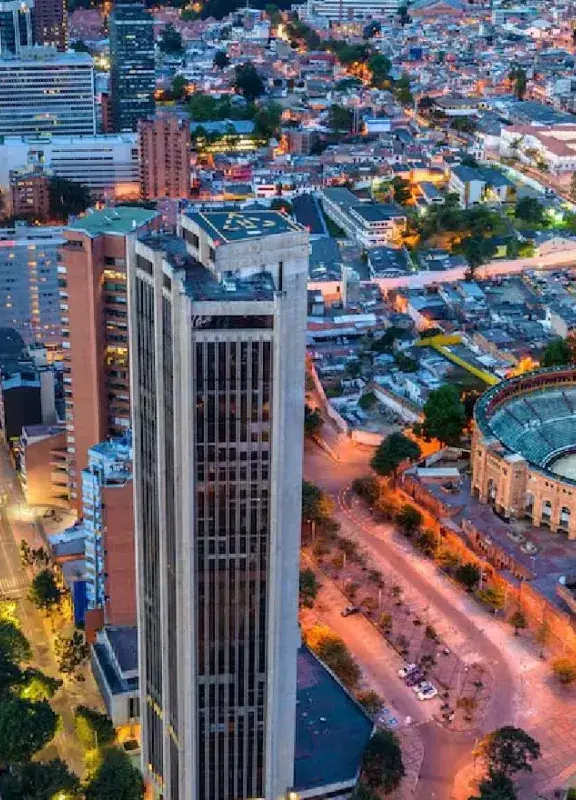FAQ: The Climate and Weather in Colombia
Climate and weather in Colombia vary drastically depending on your destination. Check out our FAQ and be prepared for your visit!
Aerial view of white beach with palm trees and turquoise sea in San Andres.Colombia’s climate is hot and tropical, right?
In some parts of the country, the climate is indeed tropical. In fact, 86 percent of the country’s area is considered hot. But the country does not have a uniform warm climate. You’ll find temperate and chilly climates in cities such as Medellín or Bogotá.
What makes Colombia’s climate so diverse?
Fluctuations in temperatures and rainfall levels are due mainly to changes in elevation. Much of the western part of Colombia is covered by the Andes Mountains, where every 1,000-foot increase in altitude means an estimated 3.5°F temperature decrease. In other words, very hot temperatures at sea level cool down the higher you go.
What ranges of climate will I find in Colombia?
You’ll likely hear Colombians describe their country’s climate in three ways: hot, temperate and cold. The hot zone (tierra caliente) is from sea level to 900 meters the temperate zone (tierra templada) is between 900 and 1,980 meters and the cold zone (tierra fría) is from 1,980 to about 3,500 meters. Above that, páramos (moorlands) and snow-covered areas extend to approximately 4,500 meters. These altitude-driven variations in climate are known as thermal floors, or pisos térmicos. Altitude controls not only the climate but also the country’s plant and animal life. And due to Colombia’s geography, it boasts one of the highest levels of biodiversity in the world!
Are there any seasons in Colombia?
Due to Colombia’s proximity to the Equator, you won’t find four clearly defined seasons here like in other parts of the world. Instead, seasons are characterized more by rain fluctuations than by temperature changes. A year has two clearly identifiable times: rainy season and dry season. The rainy season comes in April to May and October to November, and dry season is usually in December to January and July to August, though this can vary considerably.
Colombia is strongly influenced by the El Niño and La Niña climatic phenomena. El Niño brings warmer, drier weather and La Niña brings colder, wetter weather.
What will the weather be like where I’m going, and what should I pack?
There are, broadly, five regions in Colombia that can be distinguished by climate and landscape. Here’s what you can expect to find when traveling to each:
1. The Andean Region:
You’ll find the full range of climates in theAndes Mountainsin Colombia—hot, temperate and cold. For instance, the main cities of Bogota, Medellín and Cali all rest in this zone, where temperatures range drastically. Bogotá is chilly, Medellín is the “city of eternal spring,” and Cali is warm.
Packing tips: For a trip to the mountain regions, prepare for temperature changes by bringing layers. Low laying areas will be warm and pleasant, and you’ll want sandals in addition to comfortable walking shoes. In temperate areas, like Medellín and the coffee growing region, you may choose between sandals and closed-toe shoes depending on the plan and occasion. If you plan to visit Bogotá or other places at high altitude, you’ll definitely need warm socks and sturdy, closed-toe shoes, a warm sweater and pants, and preferably a jacket. A light rain jacket and/or umbrella will help fend off downpours, especially during the rainy season (April to May and October to November).
2. The Caribbean coast:
The coastal lowlands in the northeast experience a tropical climate, with hot temperatures year-round, plus high humidity. The wet season, between May and November, is slightly hotter than the dry season. Cartagena, in the middle of the Caribbean coast, sees an average high of 32°C (90°F) for most of the year. To the east of Cartagena, Barranquillais even hotter.
Packing tip: Be sure to pack light, loose clothing and comfortable shoes for touring around. If you plan to do more adventure hiking, such as in Parque Tayrona, you’ll be thankful for a pair of sturdy shoes or sandals. And don’t forget a bathing suit, sunglasses, a hat and plenty of sun block—this is a great place to swim and sunbathe. Inquire about Yellow Fever vaccination before traveling here.
3. The Pacific Coast:
The Pacific coast in the northwest of Colombia also has a hot, tropical climate, but rainfall is higher, and year-round. In fact, this is one of the wettest places in the world. Buenaventura, in the middle of the Pacific Coast, receives annual rainfall over 7,000 mm (700 cm). October is its wettest month and January is its driest.
Packing tip: You should bring plenty of waterproof clothes and plastic bags to store clothes and electric gadgets. Don’t forget the mosquito repellent. Also inquire about Yellow Fever vaccination before traveling here.
4. The plains of the Orinoco:
With its subtropical semi-arid, steppe climate, this region is typically dry and windy with large fluctuations in temperature and one long rainy season from May to October.
Packing tip: Light, comfortable clothes for the dry, hot temperatures. Here you’ll see men in cowboy hats and women in flowing skirts.
5. The Amazon:
This region is humid and tropical, with high rainfall and warm daytime temperatures. The constant rain and high heat leads to high humidity mist is common in the jungle!
Packing tip: Very light clothing for the Amazon Basin is required, but it’s a good idea to pack long sleeves and pants for the evenings to prevent mosquito bites. You’ll want sturdy shoes or hiking boots that are comfortable for walking, as well as sandals or shoes you don't mind getting wet. For the rain, a light, water-resistant jacket or poncho will be useful.
 Welcome, you are in
Welcome, you are in 













